Mango Tanghulu has quickly become one of my favorite sweet treats, blending tropical fruitiness with an irresistible sugary crunch. If you’ve ever wandered through bustling Asian street markets or scrolled through food reels online, you’ve probably seen glossy skewered fruits crackling under a hard candy shell—that’s tanghulu. And when you swap in ripe, juicy mango? Magic happens.
Hi, I’m Sifaw. I’m not a chef by trade, just a curious home cook who’s been lucky enough to taste and test recipes from around the world. My first encounter with this candied fruit snack happened on a misty morning in Taipei, and the sound of that sugar shell cracking still lingers in my memory. That’s what led me to experiment with mango, one of my all-time favorite fruits, to create something delightfully crunchy, juicy, and just the right amount of sweet.
In this article, I’ll walk you through everything you need to know to make Mango Tanghulu at home—from its traditional roots to a detailed recipe, troubleshooting tips, flavor ideas, and health insights. Whether you’re making it for fun, for family, or just to treat yourself, this guide will leave you craving more.
Table of Contents
Understanding Mango Tanghulu
What is Tanghulu and How Mango Transforms It
Tanghulu is a traditional Chinese street snack that originated in northern China, most often made with hawthorn berries skewered on a stick and coated in a brittle sugar glaze. The result is a sharp crack as your teeth break through the coating, followed by the tart, tender fruit inside.
So, where does mango fit in?
While hawthorn was the original star, modern twists have brought strawberries, grapes, and now—succulent mango—into the mix. This tropical fruit adds flair, turning the snack into a fusion of East Asian tradition and global flavor. Its bright orange color, juicy flesh, and natural sweetness make it a visually stunning and deliciously addictive variation.
This version of tanghulu isn’t just a pretty skewer. The contrast between the cold, juicy mango and the hot, glassy sugar coating creates a mouthfeel that’s pure joy. It’s crunchy. It’s juicy. It’s everything a sweet snack should be.
It’s no wonder that Mango Tanghulu has taken off on social media—it’s the perfect mix of visual appeal and addicting taste.
Origins of Tanghulu and Its Modern Fruity Twist with Mango
The story of tanghulu stretches back over 800 years to the Song Dynasty. Originally meant as a medicinal snack to boost appetite, it quickly evolved into a beloved street food. Vendors across Beijing, Shanghai, and now even LA or NYC offer versions that range from classic to avant-garde.
Adding mango to the lineup may not be traditional, but it’s part of a larger movement of reimagining time-honored recipes. I see Mango Tanghulu as a respectful evolution—celebrating the past while embracing creativity.
Print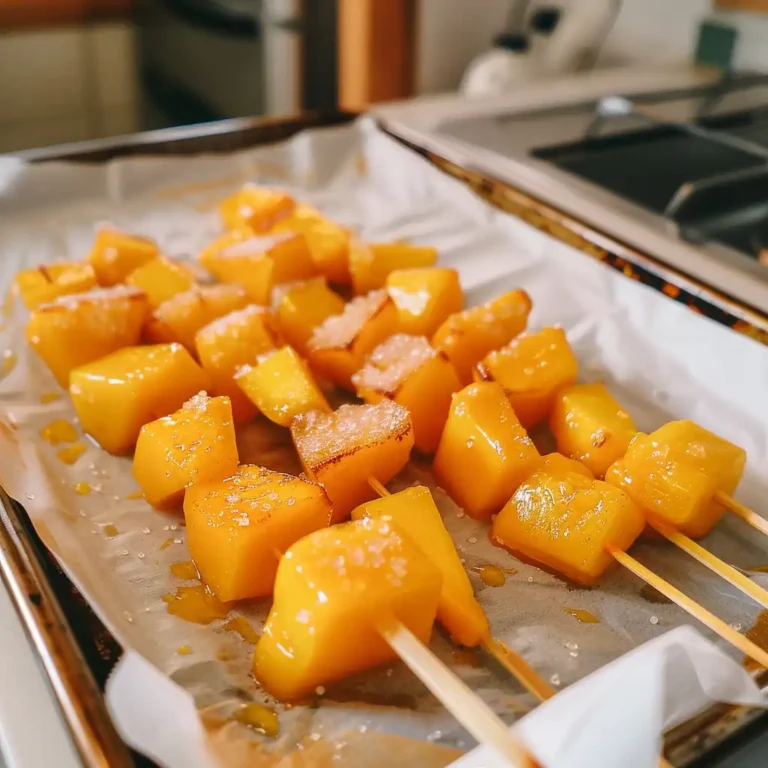
Mango Tanghulu: A Sweet Crunchy Delight from East Asia
Crunchy, glossy sugar-coated mango skewers—a tropical twist on the traditional Chinese street snack, Tanghulu.
- Total Time: 25 minutes
- Yield: 4 skewers
Ingredients
- 2 firm mangoes (Ataulfo or Honey mangoes preferred)
- 1 cup white sugar
- 1/2 cup water
- 1 teaspoon lemon juice (optional)
- Skewers (wooden or bamboo)
- Parchment paper or silicone mat
- Candy thermometer or ice water bowl (for checking hard crack stage)
Instructions
- Peel mangoes and cut into 1-inch chunks.
- Dry mango chunks thoroughly with paper towels.
- Skewer 2–3 chunks per stick, spacing slightly.
- Combine sugar, water, and lemon juice in a saucepan.
- Bring to boil without stirring; cook until syrup reaches 300°F or hard crack stage (about 8–10 mins).
- Remove from heat immediately once temperature is reached.
- Dip each skewer quickly into syrup to coat all sides.
- Let excess syrup drip, then lay on parchment to harden for 5 minutes.
- Serve fresh for best crunch. Store up to 6 hours in cool dry conditions if needed.
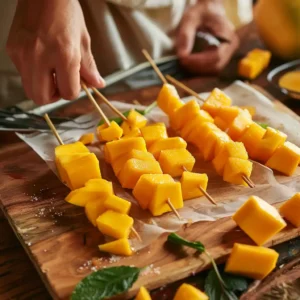
Notes
Use slightly underripe mangoes for better hold and syrup adhesion. Avoid overripe mangoes to prevent slipping or sogginess. For extra flavor, try adding citrus zest or a hint of chili before dipping.
- Prep Time: 15 minutes
- Cook Time: 10 minutes
- Category: Dessert
- Method: No Bake
- Cuisine: Asian Fusion
Nutrition
- Serving Size: 1 skewer
- Calories: 130
- Sugar: 22g
- Sodium: 0mg
- Fat: 0g
- Saturated Fat: 0g
- Unsaturated Fat: 0g
- Trans Fat: 0g
- Carbohydrates: 33g
- Fiber: 1g
- Protein: 0g
- Cholesterol: 0mg
Ingredients & Tools for Making Mango Tanghulu
Essential Ingredients for Mango Tanghulu
When making Mango Tanghulu, simplicity is key. This is one of those recipes where a few quality ingredients make all the difference. Here’s what you need to get that perfect crackly glaze and juicy bite:
| Ingredient | Purpose |
|---|---|
| Fresh Mango | Main fruit—choose firm, slightly under-ripe ones |
| White Sugar | For the hard candy shell |
| Water | To dissolve sugar and control syrup thickness |
| Lemon Juice (optional) | Helps prevent crystallization and adds brightness |
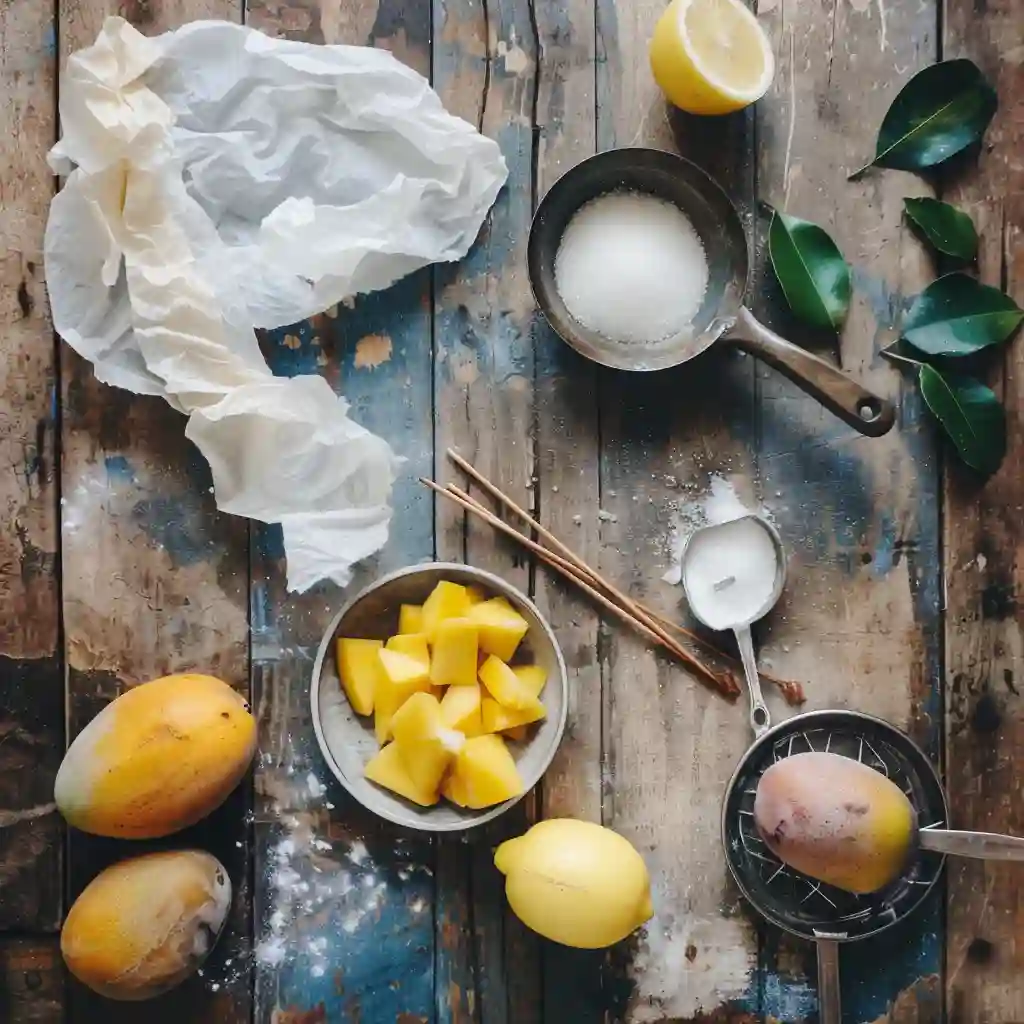
Tip from my kitchen: Go for Ataulfo or Honey mangoes if you can find them—they’re rich in flavor but not overly watery, which helps the sugar stick better.
I once tried making this with super-ripe mango and, let me tell you, it was a juicy mess. The syrup wouldn’t cling, and the skewers just slipped out. That’s why firmness is everything!
Tools and Kitchen Setup You Need to Get It Right
Making Mango Tanghulu isn’t hard, but having the right tools on hand saves a lot of frustration. Here’s what I recommend:
| Tool | Why You Need It |
|---|---|
| Skewers | To hold mango chunks (wooden or bamboo preferred) |
| Candy Thermometer | To monitor sugar temperature (around 300°F) |
| Saucepan | For boiling the sugar and water mix |
| Parchment Paper or Silicone Mat | For cooling the dipped fruit |
| Slotted Spoon or Tongs | For safe and quick syrup dipping |
| Ice Water Bowl | Optional—for checking syrup hard crack stage |
Pro tip: If you don’t have a candy thermometer, drop some syrup in ice water. If it hardens instantly and cracks, it’s ready.
The candy-making process moves quickly, so line everything up before you even turn on the stove. Think of it as a little dance—every move counts.
Step-by-Step Recipe to Make Mango Tanghulu at Home
Prepping the Mango the Right Way
When it comes to Mango Tanghulu, preparation is everything. The texture of the mango, how you cut it, and even how dry it is will make or break your final result. Here’s how I prep mine, every single time.
- Choose the right mango – Firm, slightly underripe mangoes work best. They hold their shape and won’t fall apart when skewered or dipped.
- Peel and cube – Peel the skin off gently using a peeler or knife. Cut the mango into 1-inch chunks. Avoid too small or too soft pieces.
- Dry thoroughly – This step is crucial. Use paper towels to blot each mango piece. Moisture prevents the sugar from sticking, so they need to be bone-dry.
Once your mango chunks are ready, slide 2–3 pieces onto each skewer. Not too crowded—give them room for that beautiful sugar coat.
Making the Sugar Syrup: Consistency and Timing
This is where the magic happens—your syrup. It’s what gives tanghulu that iconic glassy shell and audible crunch. The process is quick, so stay focused.
Ingredients:
- 1 cup white sugar
- ½ cup water
- 1 teaspoon lemon juice (optional but helpful)
Instructions:
- Combine and boil – In a medium saucepan, combine sugar, water, and lemon juice. Stir just until the sugar dissolves.
- Watch the temperature – Bring it to a boil without stirring again. Let it reach 300°F (the hard crack stage). This usually takes 8–10 minutes. If you don’t have a thermometer, test by dripping syrup into ice water—it should harden immediately and crack when bent.
- Turn off heat immediately – Once it reaches the right temp, remove from heat quickly to avoid burning.
Be very cautious here—the syrup is dangerously hot and sticky.
Dipping Technique for That Perfect Glassy Crunch
Now comes the fun—and slightly nerve-wracking—part: dipping your skewers.
- Dip the mango skewers one at a time, rolling them quickly in the hot syrup to fully coat all sides.
- Let excess drip off, then immediately lay them on a parchment-lined tray or silicone mat to harden.
- Wait 5 minutes – The sugar coating will set fast into a clear, glossy shell.
And just like that, you’ve made your first Mango Tanghulu! The glaze should be crisp and shiny, while the mango inside stays fresh and juicy. The contrast is unreal—like biting into sunshine.
Ready to avoid the common pitfalls I learned the hard way? In the next section, I’ll share my personal tips and tricks to perfect your mango tanghulu every single time. Let’s go!
Tips and Tricks for the Perfect Mango Tanghulu
Avoiding Common Mistakes (Crystallizing Sugar, Soggy Fruit)
Let me tell you, the road to perfect Mango Tanghulu is paved with sticky setbacks. My first few tries ended in sugar that crystallized too early, mango that slipped off the skewer, or worse—no crunch at all. So, here’s what I’ve learned to avoid.
1. Sugar crystallization
This happens when you stir the syrup after it starts boiling or if rogue sugar crystals stick to the sides of the pan.
Fix it:
- Use a clean, wet pastry brush to wipe down the sides of the pot.
- Add a little lemon juice or corn syrup to help prevent crystallization.
2. Soggy or slippery mango
Mango has a lot of juice, especially when ripe. If it’s too soft or wet, the syrup won’t stick.
Fix it:
- Choose firm mangoes and pat them completely dry.
- Chill mango chunks before dipping for extra firmness.
3. Syrup that’s too runny or too burnt
Timing is everything. If you undercook the syrup, it won’t harden. If you overcook, it turns bitter.
Fix it:
- Use a candy thermometer.
- Remove from heat the moment it hits 300°F.
Texture and Temperature: What Makes Mango Ideal
Mango stands out from other tanghulu fruits for its natural sweetness and tender bite, but not every mango is ideal.
Best types:
- Ataulfo (Honey mango): Small, creamy, and slightly firm—perfect.
- Kent or Haden: Bigger mangoes with firm flesh and fewer fibers.
Avoid:
- Overripe mangoes that feel mushy or have stringy fibers.
Temperature tips:
- Prep your mango ahead and keep it cold before dipping.
- Serve tanghulu immediately or refrigerate for up to 2 hours to retain the crunch.
Honestly, the most satisfying thing is hearing that “crack” as you bite in—and then tasting the silky mango underneath. That contrast? Pure gold.
In the next part, I’ll take you deeper into what Mango Tanghulu actually tastes like and how it ties into East Asian street food culture. Spoiler: it’s not just about sweetness—it’s about balance. Let’s go!
Flavor Profile and Cultural Significance
What Mango Tanghulu Tastes Like: Sweet, Tart, and Tropical
If I had to describe the taste of Mango Tanghulu in one word, it would be contrast. The crisp shell offers an instant crunch followed by a burst of tropical juice from the mango inside. It’s an experience—almost like a candy apple and a tropical smoothie had a baby.
Here’s what you can expect:
- The first bite: A satisfying, crackly sound as your teeth break through the thin sugar shell.
- Then comes the mango: Juicy, slightly tangy, and mellow-sweet—especially if you’ve chosen a firm but ripe variety.
- The balance: The hardened sugar adds a neutral sweetness and slight caramel note, which balances the fruit’s acidity.
Mango Tanghulu doesn’t coat your mouth in sugar the way many Western candies do. Instead, it offers a clean sweetness, then disappears—leaving behind the mango’s tropical flavor.
Cultural Background: How Tanghulu Evolved from Hawthorn to Mango
The roots of tanghulu stretch back over 800 years to imperial China. Back then, hawthorn berries were used for their medicinal qualities, especially for aiding digestion. These berries, naturally tart and dense, were skewered and dipped in syrup to make them more palatable.
Tanghulu gained popularity on the streets of Beijing and became a winter favorite. The cold weather helped the sugar set quickly and stay crisp longer.
But just like food traditions everywhere, tanghulu evolved. As fruits like strawberries, grapes, and blueberries became more widely available, vendors experimented with new versions. Mango came into play as East Asian cuisine began embracing tropical influences and cross-cultural fusion.
I first tried mango tanghulu from a night market cart in Bangkok, where a street vendor fused Thai mangoes with the tanghulu method. It was love at first bite. That vibrant orange mango paired with a glassy coat reminded me how food travels and adapts.
So while mango isn’t part of tanghulu’s original story, it’s a welcome addition—a symbol of how food evolves through time, travel, and curiosity.
Mango Variations and Flavor Twists
Using Flavored Sugar and Spices
Once you’ve nailed the basic Mango Tanghulu recipe, it’s time to level up. I love giving my tanghulu a little twist—just enough to surprise the palate without overwhelming that tropical mango flavor.
Here are some fun flavor upgrades I’ve tried and loved:
- Cinnamon-infused syrup: Add a small cinnamon stick while boiling your sugar. It adds warmth and a slight spiced edge.
- Vanilla essence: Just a drop gives your syrup a creamy undertone that complements the mango’s richness.
- Citrus zest: A pinch of lime or orange zest stirred into the syrup just before dipping adds zing and brightens the sweetness.
- Chili powder (Tajin-style): If you like sweet and spicy, lightly dust the mango pieces with chili powder before dipping them in syrup. The result? A spicy-crunchy tropical bomb.
Trust me, when I added a hint of chili-lime seasoning to the mango, it was gone within minutes at our last family potluck.
Mango Plus Combo Fruits (Grapes, Kiwi, Strawberry) on One Skewer
Why stop at mango? The beauty of tanghulu is that it’s endlessly customizable. Some of the most fun I’ve had in the kitchen involved experimenting with fruit medleys on a single skewer.
Try these combos:
| Combo Skewer | Flavor Profile |
|---|---|
| Mango + Strawberry | Juicy, sweet, and slightly tangy |
| Mango + Grape | Crisp meets juicy sweetness |
| Mango + Kiwi | Tart and tropical with a citrusy punch |
| Mango + Blueberry | Soft burst with mango’s firm sweetness |
Pro Tip: Always skewer firmer fruits first, then the softer ones. This helps prevent delicate fruits from sliding down during dipping.
One time I made mango-strawberry-kiwi skewers for a friend’s birthday picnic. We laid them out in a rainbow display—and not a single skewer made it past the first hour.
Storage, Shelf Life, and Serving Ideas
How to Store Mango Tanghulu for Max Crispiness
Here’s the deal with Mango Tanghulu—it’s best when eaten fresh, within an hour or two after making it. But if you’ve made a batch ahead of time (been there), here’s how to store it without losing that glorious crunch.
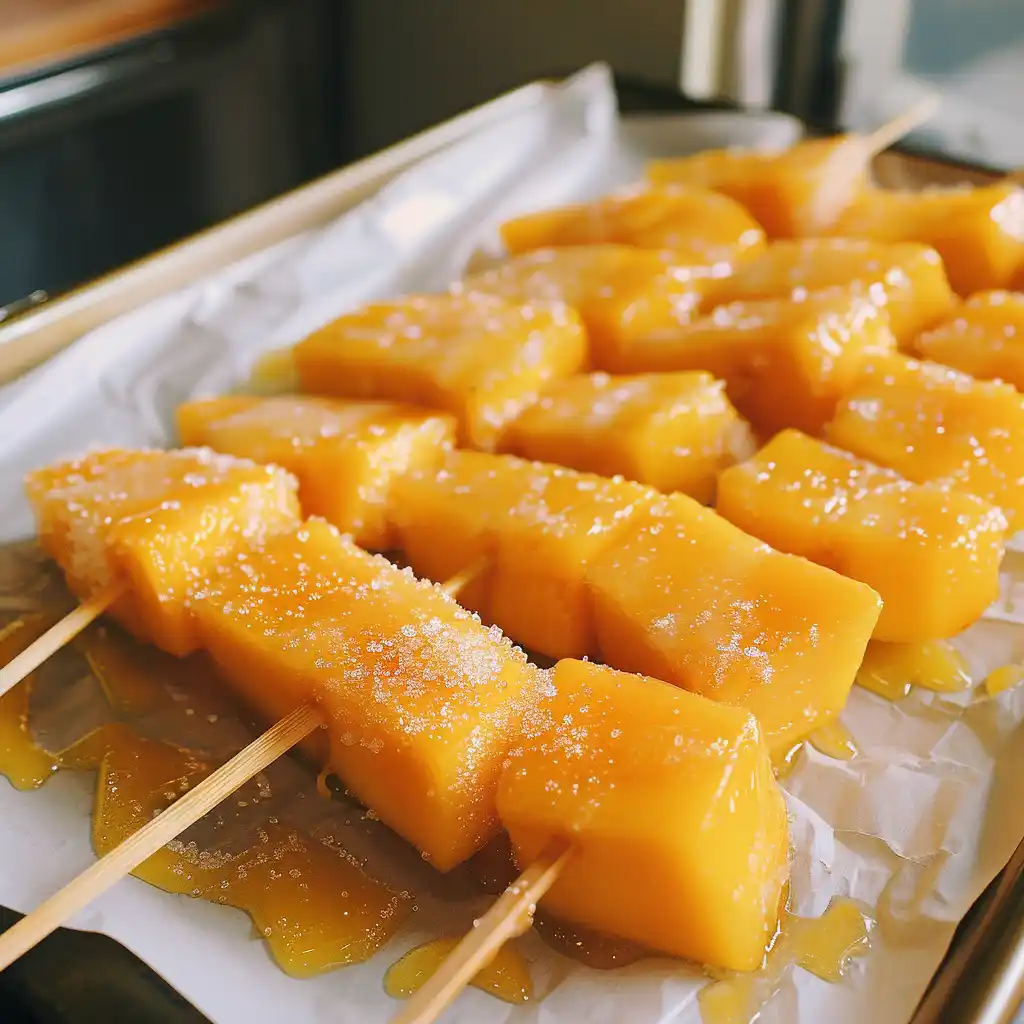
Short-term storage (1–3 hours):
- Lay the skewers flat on parchment paper in a single layer.
- Keep them at room temperature in a cool, dry spot—don’t stack them!
- Avoid plastic containers with lids; they trap moisture, which melts the candy shell.
Refrigeration (up to 6 hours max):
- Store loosely covered in the fridge, ideally in a container lined with parchment.
- Do not freeze—the syrup cracks and melts unevenly during thawing.
Tip from my experience: I once left them uncovered in the fridge overnight. The sugar absorbed moisture and turned tacky. Lesson learned—fresh is always best!
Serving Ideas: Pairings, Plating, and When to Serve It
Mango Tanghulu isn’t just a snack—it’s a showstopper. That golden-orange shine looks beautiful at parties, brunch tables, and dessert bars. Here are some ways I love to serve it:
| Occasion | Serving Idea |
|---|---|
| Afternoon snack | Paired with jasmine tea or cold matcha |
| Summer picnic | With fresh berries and mint leaves |
| Dessert platter | |
| Kids’ birthday party | Mini skewers with one mango chunk and sprinkles |
Presentation tip: Stand the skewers upright in a foam block or a short jar lined with rice—it keeps them crisp and makes for an eye-catching centerpiece.
Sometimes, I even use tanghulu as a topper for cakes and cupcakes—just one mango skewer standing tall adds flair and crunch.
Health, Nutrition, and Dietary Insights
Is Mango Tanghulu Healthy? Sugar Content and Moderation Tips
Let’s be honest—Mango Tanghulu is not a health food. It’s fruit wrapped in hardened sugar. But here’s the good news: because it’s made with real, whole mango and a small amount of syrup per piece, it can be enjoyed mindfully.
Here’s a rough breakdown for one skewer (about 3 mango chunks):
| Nutrient | Approx. Amount |
|---|---|
| Calories | 120–150 kcal |
| Sugar (natural + syrup) | 20–25g |
| Fiber | 1–2g |
| Vitamin C | 10–15% DV |
Most of the sugar comes from the candy coating. So, while Mango Tanghulu isn’t low-carb or low-sugar, it’s certainly better than artificial store-bought candies with preservatives and dyes.
Tips to enjoy without guilt:
- Limit to 1–2 skewers.
- Pair with protein or fiber-rich snacks to reduce sugar spikes.
- Make mini skewers (2 mango chunks max) for portion control.
Fun fact: Because mango contains natural enzymes and antioxidants, you still get some health perks—especially when the fruit’s not overripe.
Possible Substitutes for a Vegan or Low-Sugar Version
Looking for a cleaner version? I got you. Here’s how to tweak the traditional Mango Tanghulu recipe for different diets:
| Diet Need | Substitution Tip |
|---|---|
| Vegan-friendly | Use organic cane sugar with no bone char processing |
| Low sugar | Lightly glaze with monk fruit syrup or allulose |
| Diabetic-friendly | Skip the shell and chill mango with lime & chili |
| Add-ins | Try chia seeds or hemp hearts on the syrup before it sets |
Note: Sugar substitutes often don’t harden the same way as white sugar, so you might not get the same crunch. But you can still enjoy a sweet mango snack with a hint of glaze and fewer carbs.
I’ve played around with monk fruit syrup—it didn’t form a hard shell, but the flavor was still awesome and far less sweet. Sometimes, flavor wins over texture, and that’s okay.
Now let’s switch gears and take a tasty tour of some mango dessert ideas you’ll love just as much as Mango Tanghulu. You’re going to want to bookmark these!
Mango-Inspired Desserts You’ll Love
If Mango Tanghulu has you hooked, then get ready—because I’ve explored dozens of mango-based desserts that celebrate this juicy, golden fruit in all its tropical glory. Whether you’re craving something creamy, frozen, or chewy, I’ve rounded up some of my all-time favorites you need to try next.
FAQs About Mango Tanghulu
Can you use mango for tanghulu?
Absolutely! Mango works beautifully in tanghulu because of its sweet-tart flavor and firm texture—just make sure it’s not overly ripe. Firmer chunks hold better on skewers and allow the sugar shell to harden properly.
What is tanghulu traditionally made of?
Tanghulu originated in China and was traditionally made using hawthorn berries. These small, tart fruits were skewered and dipped in a hard sugar glaze, often enjoyed during the cold months for their crisp texture.
What are the ingredients for tanghulu?
At its core, tanghulu only requires three ingredients: sugar, water, and fruit. For mango tanghulu, you’ll need fresh mango chunks, white sugar, and water—lemon juice is optional to prevent crystallization and enhance flavor.
What does tanghulu taste like?
Tanghulu offers a unique contrast: a brittle, sweet sugar coating that shatters in your mouth, followed by the juicy, fresh burst of fruit. With mango, the flavor is tropical, bright, and perfectly balanced between sweet and slightly tangy.
Conclusion
There you have it—Mango Tanghulu in all its crackly, juicy glory. From its ancient Chinese roots to your modern kitchen, this fruity street snack has transformed into something fun, flavorful, and absolutely Instagram-worthy.
Whether you’re a beginner just experimenting with sugar syrup or a home cook ready to wow guests at your next party, this guide has everything you need to get started. And once you’ve mastered Mango Tanghulu, don’t forget to explore more mango-infused desserts that bring sunshine into every bite.
If you try it, tag me and share your creations. I’d love to see your mango moments!
For more sweet inspiration, follow me on Facebook and Pinterest where I share all the behind-the-scenes kitchen experiments and upcoming treats.
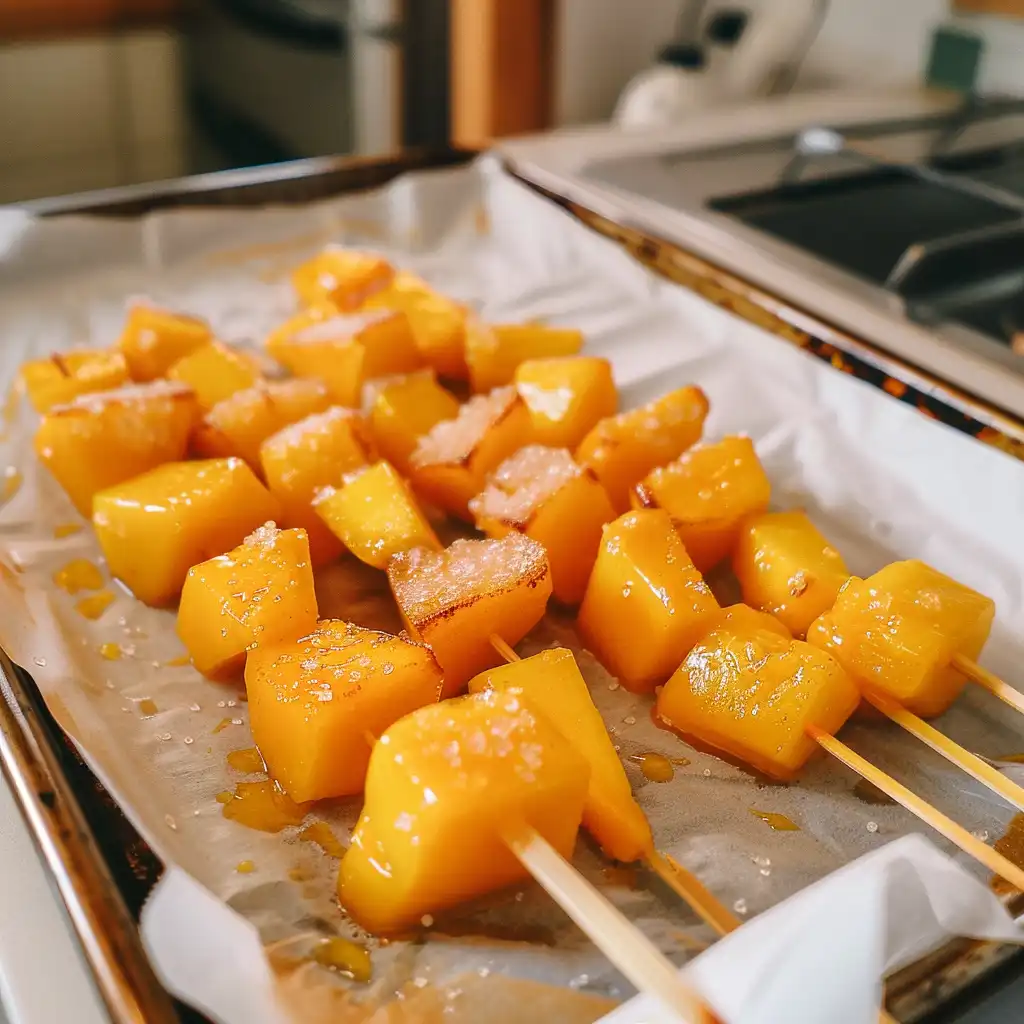

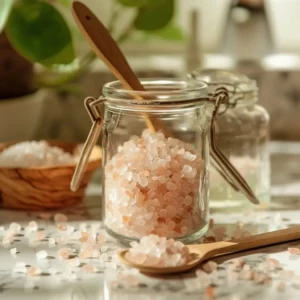
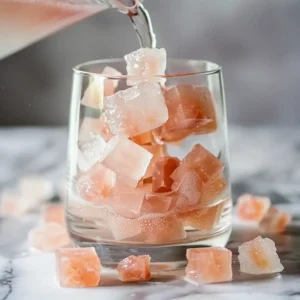




1 thought on “Mango Tanghulu: A Sweet Crunchy Delight from East Asia”